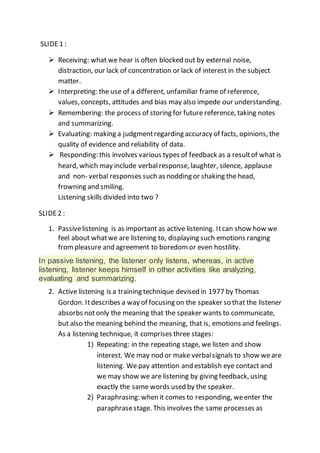
Penjelas ppt decull
- 1. SLIDE1 : Receiving: what we hear is often blocked out by external noise, distraction, our lack of concentration or lack of interest in the subject matter. Interpreting: the use of a different, unfamiliar frame of reference, values, concepts, attitudes and bias may also impede our understanding. Remembering: the process of storing for future reference, taking notes and summarizing. Evaluating: making a judgmentregarding accuracy of facts, opinions, the quality of evidence and reliability of data. Responding: this involves various types of feedback as a resultof what is heard, which may include verbalresponse, laughter, silence, applause and non- verbal responses such as nodding or shaking the head, frowning and smiling. Listening skills divided into two ? SLIDE2 : 1. Passivelistening is as important as active listening. Itcan show how we feel about whatwe are listening to, displaying such emotions ranging frompleasure and agreement to boredom or even hostility. In passive listening, the listener only listens, whereas, in active listening, listener keeps himself in other activities like analyzing, evaluating and summarizing. 2. Active listening is a training technique devised in 1977 by Thomas Gordon. Itdescribes a way of focusing on the speaker so that the listener absorbs notonly the meaning that the speaker wants to communicate, but also the meaning behind the meaning, that is, emotions and feelings. As a listening technique, it comprises three stages: 1) Repeating: in the repeating stage, we listen and show interest. We may nod or make verbalsignals to show weare listening. We pay attention and establish eye contact and we may show we are listening by giving feedback, using exactly the same words used by the speaker. 2) Paraphrasing: when it comes to responding, weenter the paraphrasestage. This involves the same processes as
- 2. repeating, but it is also important to give feedback by using similar phrases to the speaker. 3) Reflecting: the final stage occurs when wegive feedback to the speaker using our own words and approach. SLIDE3 : Silence What is immediately obvious aboutactive listening is that it is a much more reflective, quieter and calmer process. Itallows us to absorb how the speaker feels as well as the actual message. Itallows time for us to reflect and to formulatein our turn a reasoned responsewhich agrees common ground, but also allows us to state our own point of view. Silence is much more of a tradition in countries like Japan, China and Finland. SLIDE4 : Networking Networking is a very usefulway of gaining information, researching a problem and opinion making. Itis often the key to successfulbusiness relationships, and the conversation around the water- cooler, the formalbanquet and the coffee break are all networking opportunities to get to know people personally. 1. Three qualities are essential to effective networking: 2. the ability to listen, which we have covered earlier in this chapter; 3. the ability to empathize; the ability to ask questions. SLDE5 : The UNEC projectIn 2008, theEU Uniting Europe through Culture (UNEC) projectprovided a formula for analysing cultural differences. It identified five steps for dealing with cultural communication misunderstanding and behaviouraldifferences by analysing cultural experience: I. Know your own culture. Understand whathappens in your own culture.
- 3. II. Identify difference. Examine what is differentin the foreign culture fromthe expected communication styleor behaviour in your own culture. III. Empathize. Attempt to understand why people in the foreign culture communicate or behave in different ways fromwhat you expect. IV. Use your cross- culturalskills to manage the difference. Analysewhat you need to do to adapt in order to achieve a successfuloutcome. V. Reflect on what you have learned from the experience and how it will influence futurebehaviour. Analysewhat you will do, say and think when you next face a similar situation. SLIDE6 : o Non- verbalcommunication (NVC) ‘We speak with our vocal organs, butwe conversewith our whole body’ (Abercrombie, 1970). This quotegives a very apposite description of what wegenerally call body language. People convey meaning in NVC through their posture, gestures, eye contact, the physicaldistancethey keep when communicating and how they dress. NVC is very often extremely subtle and subconscious. NVC, often loosely called ‘body language’, should not be considered as something separatefromspeech, but rather as existing simultaneously with verbalcommunication. Itgives out messages all the time. The verbal componentof a face- to- face conversation is less than 35 per cent and over 65 per cent of communication is done non- verbally (Mehrabian, 1981). Wecommunicate so much of our message non- verbally in conversation that, in many cases, the actual words weuse are not so important. How we communicate (our tone, pitch, loudness, speed, dialect, etc.) is often more important than our NVC signals. WELL , NEXT PART WILL BEEXPLAINBY LULUK !